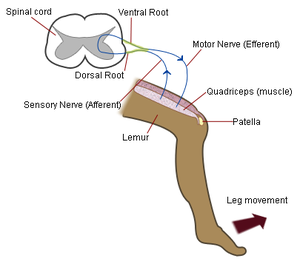
Westphal's sign
Encyclopedia

Patellar reflex
The patellar reflex or knee-jerk is a deep tendon reflex and is a myotatic reflex.-Mechanism:Striking the patellar tendon with a tendon hammer just below the patella stretches the sensory nerve fiber of the femoral nerve which synapses at the level of L4 in the spinal cord, completely independent...
or knee jerk is a kind of deep or stretch reflex
Stretch reflex
The stretch reflex is a muscle contraction in response to stretching within the muscle. It is a monosynaptic reflex which provides automatic regulation of skeletal muscle length....
where an application of a stimulus to the patellar tendon such as strike by a solid object or hammer caused the leg to extend due to such stimulus causes the quadriceps femoris muscle to contract.
It is named for Karl Friedrich Otto Westphal.
Associated conditions
Westphal's sign has a clinical significance used in determining neurodisorders or diseases such as:- receptor damage, peripheral nerve disease, involving the dorsal(sensory) columns of the spinal cord and cerebellar lesions
- lesions present within the motor cortex of the brain or the pyramidal tracts which it combined with muscular spasms
- complete interruption of sensory and/or motor impulse transmission in the femoral nerveFemoral nerveThe femoral nerve, the largest branch of the lumbar plexus, arises from the dorsal divisions of the ventral rami of the second, third, and fourth lumbar nerves...

